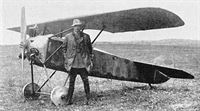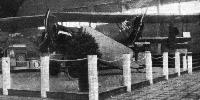A.Weyl Fokker: The Creative Years (Putnam)
The light aeroplanes V.39 and V.40
Soon after the unrest of the early days of November 1918 Platz completed two new designs. Both were low-power single-seat monoplanes intended for sporting flying. Platz built them in the belief that there were people who liked to fly for fun. What he forgot was that people who are so inclined usually lack the money needed to buy aeroplanes.
The two new aircraft were scaled-down Fok. D.VIII single-seaters. In both, however, the wing was fabric-covered. This meant that torsional loads had to be resisted entirely by differential bending of the spars. These were designed accordingly. The ailerons were simplified, being no longer inset but extending to the wing tips; their hinge lines were slightly skewed, and they had no horn balance. The elevator was also a plain surface; the rudder was balanced, but there was no fin.
Although basically similar, the V.39 and V.40 differed in size and power units. V.39 was the larger of the two, with a wing area of about 9 sq. m. (97 sq. ft.); its engine was a Gnome of 50 or 80 h.p., cowled in the same way as the engine of the Fok. D.VIII.
The V.40 was the smallest aeroplane ever built by the Fokker Works. Its wing span was only 5-9 m. (19-5 ft.), the area 7 sq. m. (75-5 sq. ft.); its length was 3-94 m. (13 ft.). The V.40 was powered by an old 35-h.p. Anzani inverted-Y air-cooled engine, and had a top speed of 111 km./hr. (69 m.p.h.).
Both aircraft flew well, and were liked by all pilots who tried them. The flight tests were done by Parge. Fokker seems never to have flown them, and it is doubtful whether they ever went to Holland. They failed to find a market and did not go into production.
A somewhat similar attempt to build a small edition of the Fok. D.VIII was made by Gabriel at Bromberg a year or so later. This aircraft, the Gabriel P.5, had a plywood-covered wing but had a plywood fuselage instead of the steel-tube structure of the Fok. D.VIII. It had a 30-h.p. Haacke two-cylinder engine and was even smaller than the Fokker V.40: its wing span was only 5 m. (16-5 ft.) and the length 4 m. (13-2 ft.). The empty weight was stated to be a mere 125 kg. (275 lb.).
J.Herris, J.Leckscheid Fokker Aircraft of WWI. Vol.5: 1918 Designs Part 1: Prototypes & D.VI (A Centennial Perspective on Great War Airplanes 55)
Fokker V39
The Fokker V39 was a sports plane offered postwar. It was very similar to a scaled down D.VIII powered by a 50 hp Gnome rotary.
Fokker V39 Specifications
Engine: 50 hp Gnome
Wing: Span 7.0 m
Area 10.2 m2
General: Length 5.02 m
Height 2.50 m
Empty Weight 210 kg
Loaded Weight 415 kg
Climb: 1000m 6 min
2000m 17.5 min
Fokker V40
There are two contradictory specifications for this type designation. According to press reports from the first postwar years and the Fokker type list of the time, the V40 was a small, single-seat sporting cockpit with a 30-35 hp Anzani radial engine. This is the aircraft shown here. It is said to have reached speeds of up to 120 km/h, although the engine caused strong vibrations. This aircraft was built in Schwerin in April 1919.
On the other hand, according to contract 344-T of June 30,1920, Fokker was to supply the American War Department with two “V40” single-seat monoplanes as cantilever parasol aircraft, equipped with 300 hp Wright-Hispano engines. In America, the aircraft were called F VI or PW-5.
Fokker V40 Specifications
Engine: 35 hp Anzani
Wing: Span 5.9 m
Area 7.0. m2
General: Length 3.94 m
Empty Weight 160 kg
Loaded Weight 266 kg
Maximum Speed (near ground level): 111 km/h
Журнал Flight
Flight, August 28, 1919.
THE E.L.T.A. SHOW
THE FOKKER STAND
<...>
The second machine on the Fokker stand is a little single-seater biplane with 80-90 h.p. Thulin (Swedish version of the Le Rhone) engine. It is designed as a sporting biplane, and has its wings placed on the fuselage top and bottom respectively, the pilot sitting in an opening in the top plane. In order to facilitate housing and transport the wing bracing is arranged so as to be quickly dismantled, when the wings, by means of suitable hooks, can be placed alongside, and supported by brackets on the fuselage. In a general way this machine is very similar to some of the earlier War machines produced by Fokker in Germany, but with, probably, a smaller engine in view of the purpose for which this machine is intended.
<...>
 |
J.Herris, J.Leckscheid - Fokker Aircraft of WWI. Vol.5: 1918 Designs Part 1: Prototypes & D.VI /Centennial Perspective/ (55)
|
| The Fokker V39 was a postwar sports aircraft. (Peter M. Grosz Collection/STDB)
|
 |
J.Herris, J.Leckscheid - Fokker Aircraft of WWI. Vol.5: 1918 Designs Part 1: Prototypes & D.VI /Centennial Perspective/ (55)
|
| Fokker V.39.
|
 |
J.Herris, J.Leckscheid - Fokker Aircraft of WWI. Vol.5: 1918 Designs Part 1: Prototypes & D.VI /Centennial Perspective/ (55)
|
| The Fokker V39 in Dutch insignia postwar. Its resemblence to the D.VIII is clear. (Peter M. Grosz Collection/STDB)
|
 |
J.Herris, J.Leckscheid - Fokker Aircraft of WWI. Vol.5: 1918 Designs Part 1: Prototypes & D.VI /Centennial Perspective/ (55)
|
|
|
 |
J.Herris, J.Leckscheid - Fokker Aircraft of WWI. Vol.5: 1918 Designs Part 1: Prototypes & D.VI /Centennial Perspective/ (55)
|
| The Fokker V39 was a postwar sports aircraft.
|
 |
A.Weyl - Fokker: The Creative Years /Putnam/
|
| Harry Rother lends scale to the tiny Fokker V.40.
|
 |
J.Herris, J.Leckscheid - Fokker Aircraft of WWI. Vol.5: 1918 Designs Part 1: Prototypes & D.VI /Centennial Perspective/ (55)
|
| The Fokker V39 was a postwar sports aircraft.
|
 |
J.Herris, J.Leckscheid - Fokker Aircraft of WWI. Vol.5: 1918 Designs Part 1: Prototypes & D.VI /Centennial Perspective/ (55)
|
| For the transfer to the Netherlands, the V45 was given a modified livery and the lettering 'Fokker.' The V40 is at left. (Peter M. Grosz Collection/STDB)
|
 |
Журнал - Flight за 1919 г.
|
| The Fokker Stand: On the left may be seen the port wing of a parasol monoplane, while in the centre is a sporting two-seater, shown with the port wings folded for transport. In the background, on the right, is a Fokker two-seater biplane, similar to the German Fokker type D.VII.
|
 |
J.Herris, J.Leckscheid - Fokker Aircraft of WWI. Vol.5: 1918 Designs Part 1: Prototypes & D.VI /Centennial Perspective/ (55)
|
| The uncovered Fokker V40 airframe in the foreground. The V37 prototype airframe is in the background and provides a good size comparison. (Peter M. Grosz Collection/STDB)
|
 |
J.Herris, J.Leckscheid - Fokker Aircraft of WWI. Vol.5: 1918 Designs Part 1: Prototypes & D.VI /Centennial Perspective/ (55)
|
| The Fokker V40 under construction. (Peter M. Grosz Collection/STDB)
|
 |
J.Herris, J.Leckscheid - Fokker Aircraft of WWI. Vol.5: 1918 Designs Part 1: Prototypes & D.VI /Centennial Perspective/ (55)
|
|
|
 |
J.Herris, J.Leckscheid - Fokker Aircraft of WWI. Vol.5: 1918 Designs Part 1: Prototypes & D.VI /Centennial Perspective/ (55)
|
|
|
 |
J.Herris, J.Leckscheid - Fokker Aircraft of WWI. Vol.5: 1918 Designs Part 1: Prototypes & D.VI /Centennial Perspective/ (55)
|
| Fokker V 39
|
 |
J.Herris, J.Leckscheid - Fokker Aircraft of WWI. Vol.5: 1918 Designs Part 1: Prototypes & D.VI /Centennial Perspective/ (55)
|
| Fokker V 40
|

